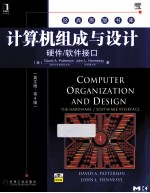
- 作 者:(美)帕特森,(美)亨尼斯著
- 出 版 社:北京:机械工业出版社
- 出版年份:2013
- ISBN:9787111412373
- 标注页数:888 页
- PDF页数:911 页
请阅读订购服务说明与试读!
订购服务说明
1、本站所有的书默认都是PDF格式,该格式图书只能阅读和打印,不能再次编辑。
2、除分上下册或者多册的情况下,一般PDF页数一定要大于标注页数才建议下单购买。【本资源911 ≥888页】
图书下载及付费说明
1、所有的电子图书为PDF格式,支持电脑、手机、平板等各类电子设备阅读;可以任意拷贝文件到不同的阅读设备里进行阅读。
2、电子图书在提交订单后一般半小时内处理完成,最晚48小时内处理完成。(非工作日购买会延迟)
3、所有的电子图书都是原书直接扫描方式制作而成。
1 Computer Abstractions and Technology 2
1.1 Introduction 3
1.2 Below Your Program 10
1.3 Underthe Covers 13
1.4 Performance 26
1.5 The Power Wall 39
1.6 The Sea Change:The Switch from Uniprocessors to Multiprocessors 41
1.7 Real Stuff:Manufacturing and Benchmarking the AMD Opteron X4 44
1.8 Fallacies and Pitfalls 51
1.9 Concluding Remarks 54
1.10 Historical Perspective and Further Reading 55
1.11 Exercises 56
2 Instructions:Language ofthe computer 74
2.1 Introduction 76
2.2 Operations of the Computer Hardware 77
2.3 Operands of the Computer Hardware 80
2.4 Signed and Unsigned Numbers 87
2.5 Representing Instructions in the Computer 94
2.6 Logical Operations 102
2.7 Instructions for Making Decisions 105
2.8 Supporting Procedures in Computer Hardware 112
2.9 Communicating with People 122
2.10 MIPS Addressing for 32-Bit Immediates and Addresses 128
2.11 Parallelism and Instructions:Synchronization 137
2.12 Translating and Starting a Program 139
2.13 A C Sort Example to Put It All Together 149
2.14 Arrays versus Pointers 157
2.15 Advanced Material:Compiling C and Interpreting Java 161
2.16 Real Stuff:ARM Instructions 161
2.17 Real Stuff:x86 Instructions 165
2.18 Fallacies and Pitfalls 174
2.19 Concluding Remarks 176
2.20 Historical Perspective and Further Reading 179
2.21 Exercises 179
3 Arithmetic for Computers 222
3.1 Introduction 224
3.2 Addition and Subtraction 224
3.3 Multiplication 230
3.4 Division 236
3.5 Floating Point 242
3.6 Parallelism and Computer Arithmetic:Associativity 270
3.7 R.eal Stuff:Floating Point in the x86 272
3.8 Fallacies and Pitfalls 275
3.9 Concluding Remarks 280
3.10 Historical Perspective and Further Reading 283
3.11 Exercises 283
4 The Processor 298
4.1 Introduction 300
4.2 Logic Design Conventions 303
4.3 Building a Datapath 307
4.4 A Simple Implementation Scheme 316
4.5 An Overview of Pipelining 330
4.6 Pipelined Datapath and Control 344
4.7 Data Hazards:Forwarding versus Stalling 363
4.8 Control Hazards 375
4.9 Exceptions 384
4.10 Parallelism and Advanced Instruction-Level Parallelism 391
4.11 Real Stuff:the AMD Opteron X4(Barcelona)Pipeline 404
4.12 Advanced Topic:an Introduction to Digital Design Using a Hardware Design Language to Describe and Model a Pipeline and More Pipelining Illustrations 406
4.13 Fallacies and Pitfalls 407
4.14 Concluding Remarks 408
4.15 Historical Perspective and Further Reading 409
4.16 Exercises 409
5 Large and Fast:Exploiting Memory Hierarchy 450
5.1 Introduction 452
5.2 The Basics of Caches 457
5.3 Measuring and Improving Cache Performance 475
5.4 Virtual Memory 492
5.5 A Common Framework for Memory Hierarchies 518
5.6 Virtual Machines 525
5.7 Using a Finite-State Machine to Control a Simple Cache 529
5.8 Parallelism and Memory Hierarchies:Cache Coherence 534
5.9 Advanced Material:Implementing Cache Controllers 538
5.10 Real Stuff:the AMD Opteron X4(Barcelona)and Intel Nehalem Memory Hierarchies 539
5.11 Fallacies and Pitfalls 543
5.12 Concluding Remarks 547
5.13 Historical Perspective and Further Reading 548
5.14 Exercises 548
6 Storage and Other I/O Topics 568
6.1 Introduction 570
6.2 Dependability,Reliability,and Availability 573
6.3 Disk Storage 575
6.4 Flash Storage 580
6.5 Connecting Processors,Memory,and I/O Devices 582
6.6 Interfacing I/O Devices to the Processor,Memory,and Operating System 586
6.7 I/O Performance Measures:Examples from Disk and File Systems 596
6.8 Designing an I/O System 598
6.9 Parallelism and I/O:Redundant Arrays of Inexpensive Disks 599
6.10 Real Stuff:Sun Fire x4150 Server 606
6.11 Advanced Topics:Networks 612
6.12 Fallacies and Pitfalls 613
6.13 Concluding Remarks 617
6.14 Historical Perspective and Further Reading 618
6.15 Exercises 619
7 Multicores,Multiprocessors,and Clusters 630
7.1 Introduction 632
7.2 The Difficulty of Creating Parallel Processing Programs 634
7.3 Shared Memory Multiprocessors 638
7.4 Clusters and Other Message-Passing Multiprocessors 641
7.5 Hardware Multithreading 645
7.6 SISD,MIMD,SIMD,SPMD,and Vector 648
7.7 Introduction to Graphics Processing Units 654
7.8 Introduction to Multiprocessor Network Topologies 660
7.9 Multiprocessor Benchmarks 664
7.10 Roofline:A Simple Performance Model 667
7.11 Real Stuff:Benchmarking Four Multicores Using the Roofline Model 675
7.12 Fallacies and Pitfalls 684
7.13 Concluding Remarks 686
7.14 Historical Perspective and Further Reading 688
7.15 Exercises 688
